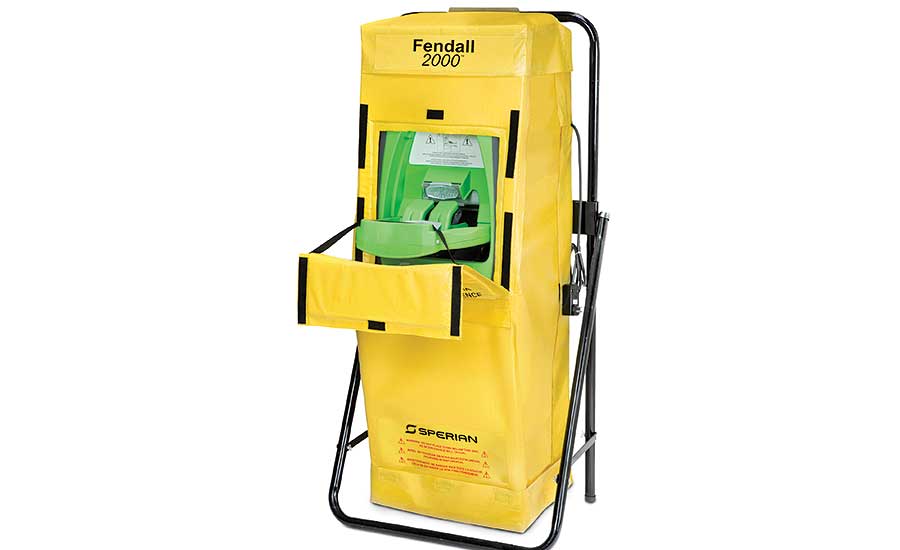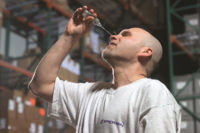Experts agree that the eyes contribute nearly 85 percent of an individual’s total knowledge. Because we rely on our eyes for nearly every activity we perform, most individuals value the sense of sight above all others. The human eye can process 36,000 bits of information every hour, and its lens is faster than any existing camera lens. No human inventions, including computer-assisted cameras, rival the human eye in complexity and function.
Protecting the eyes is crucial
Given the eyes’ complexity, size and location, they are extremely vulnerable to injury – from flying or falling objects in the yard, sand and dust particles, chemicals and vapors from household cleaning products and even ultraviolet light. And in many workplaces eye hazards are abundant.
OSHA requires employers to provide employees with suitable eye and face protection “whenever necessary to protect against chemical, environmental, radiological or mechanical irritants and hazards.” While OSHA publishes the general framework for eye protection and emergency eyewash workplace practices and hazard assessments, it refers to the American National Standards Institute standard ANSI Z87.1 for performance requirements relating to personal protective equipment and eye safety.
Still, workplace eye injuries are very common. According to OSHA, more than 2,000 people injure their eyes at work each day in the U.S. Roughly one in 10 of those individuals require one or more missed workdays to recover, and 10 to 20 percent of all occupational eye injuries result in temporary or permanent vision loss, according to OSHA.
Proper injury response
When an eye injury occurs, proper and immediate treatment is the best defense for both a positive outcome and minimal financial impact. The ANSI Z358.1-2009 standard for “Emergency Eyewash and Shower Equipment” establishes a universal minimum performance and use requirement for all eyewash and drench shower equipment used for the treatment of the eyes, face, and body of a person who has been exposed to hazardous materials and chemicals.
ANSI requires that the first step following chemical contact of any kind with the eye(s) – including caustics, acids, solvents and other hazardous materials – is immediate flushing of the eyes with water. According to the standard, such water may be any potable (drinking) water, preserved water, preserved buffered saline solution or other medically acceptable solution.
The first 10 to 15 seconds after exposure, especially a corrosive substance, are critical. Delaying treatment, even for a few seconds, may cause serious injury. ANSI calls for eyewash stations to be located within a 10-second walk from the hazard. A station must be located on the same level as the hazard with no steps, stairs or obstructions. In the case of strong caustics and strong acids, eyewash must be located immediately adjacent to the hazard. The area surrounding the station should be well lit and marked with a sign that is highly visible to everyone served by it.
Once an injured worker reaches the station, ANSI calls for the eyes to be flushed continuously for a full 15 minutes with fluid flowing at a rate of 0.4 gallons per minute for portable and plumbed eyewash stations. This fluid must be delivered at a tepid temperature, defined as ranging between 60°F and 100°F, in order to safely treat eyes without causing further injury or discomfort.
Primary eyewash delivery options
ANSI calls for eyewash to be present at the site of any hazardous material that can cause adverse effects on an individual’s health and safety. Since such hazards exist in nearly every workplace, primary eyewash stations are also required in nearly every workplace. Options available for eyewash delivery systems and the fluids they deliver are vast — but not all flushing fluids are equal in content, manufacture, safety or even intended use.
Plumbed units
Primary eyewash can be delivered by either a plumbed or a portable unit. Plumbed eyewash stations have been a long-standing solution because they deliver tap water in plentiful amounts. But they are expensive to install, impractical to move and require weekly maintenance. And tap water has been proven detrimental in treating injured eyes. Because its temperature is not easily regulated, plumbed water is often too hot or too cold to carry out ANSI’s required 15-minute flush. Since it does not match the eye’s natural pH, flushing with it can cause further irritation. Similarly, harmful microorganisms and other contaminants commonly found in tap water can cause serious long-term effects.
Portable units
Portable eyewash stations are available in a variety of styles and sizes. Portable units can easily be moved and are compact enough to fit into nearly any workspace. Units with features such as alarms, view-through windows for easy maintenance and heated coverings for cold-weather applications make portable units easier than ever to install, use and maintain.
Because they are self-contained, portable eyewash units store and deliver preserved and/or pH-balanced water, saline solution or 100 percent sterile saline at room temperature for safe and comfortable flushing.
The fluid in sealed-cartridge stations provides the longest shelf life – up to 24 months – and these stations require the least frequent maintenance, involving monthly visual checks. Portable units containing buffered saline solution closely match the natural pH of the eye to protect it during flushing.
Secondary or supplemental eyewash
Secondary, or supplemental, eyewash can be delivered in bottles or smaller portable stations. Secondary eyewash does not have the fluid capacity to flush both eyes at the rate of primary eyewash. Rather, ANSI states that supplemental eyewash “supports primary plumbed units, self-contained units or both by delivering immediate flushing fluid.” Secondary bottles or stations are required at the site of nuisance particles such as pollen, dust, sawdust and smoke as well as places where very caustic substances exist. In the case of electric storage battery handling, charging and maintenance areas where the extent of possible employee exposure to electrolytes is small, an eyewash device that contains no less than one gallon of water is an acceptable alternative to a primary station.
Secondary bottles and stations are well-suited for use in confined spaces that can’t accommodate a full-sized primary unit. Secondary eyewash systems also can be as critical for the treatment of an injured eye as their primary counterparts. In the case of chemical or caustic eye injury, eyewash bottles provide immediate treatment en route to a primary eyewash unit. They also provide continuous irrigation on the way to medical care.
Injuries still common
The FDA states that ophthalmic drug products should be sterile. But ANSI does not require emergency eyewash solution or its delivery mechanism be sterile. Yet administering non-sterile eyewash can have profoundly negative impacts on injured individuals.
Select a reputable manufacturer that supplies FDA-approved, sterile, ophthalmic-grade eyewash. That translates into the highest level of care for workers in the event of an eye injury.
The article is adapted from a Honeywell White Paper. For more information, visit www.honeywellsafety.com.

